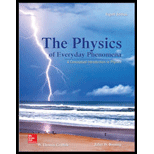
The Physics of Everyday Phenomena
8th Edition
ISBN: 9780073513904
Author: W. Thomas Griffith, Juliet Brosing Professor
Publisher: McGraw-Hill Education
expand_more
expand_more
format_list_bulleted
Concept explainers
Textbook Question
Chapter 12, Problem 30CQ
If a negative charge is moved in the same direction as the electric field lines in some region of space, does the potential energy of the negative charge increase or decrease? Explain.
Expert Solution & Answer
Want to see the full answer?
Check out a sample textbook solution
Students have asked these similar questions
Plz no chatgpt pls will upvote
No chatgpt pls will upvote
No chatgpt pls will upvote
Chapter 12 Solutions
The Physics of Everyday Phenomena
Ch. 12 - When two different materials are rubbed together,...Ch. 12 - Two pith balls are both charged by contact with a...Ch. 12 - When a glass rod is rubbed by a nylon cloth, which...Ch. 12 - Two pith balls are charged by touching one to a...Ch. 12 - Do the two metal-foil leaves of an electroscope...Ch. 12 - If you charge an electroscope with a plastic rod...Ch. 12 - When you comb your hair with a plastic comb, what...Ch. 12 - Describe how Benjamin Franklins single-fluid model...Ch. 12 - If you touch the metal ball of a charged...Ch. 12 - If you touch the ball of a charged electroscope...
Ch. 12 - When a metal ball is charged by induction using a...Ch. 12 - If, when charging by induction, you remove the...Ch. 12 - Will bits of paper be attracted to a charged rod...Ch. 12 - Why are pith balls initially attracted to a...Ch. 12 - Are electrostatic precipitators (see everyday...Ch. 12 - Can the pollutant carbon dioxide be readily...Ch. 12 - Can scrubbers (see everyday phenomenon box 12.1)...Ch. 12 - Is the concept of torque involved in the operation...Ch. 12 - If you had several identical metal balls mounted...Ch. 12 - If the distance between two charged objects is...Ch. 12 - If two charges are both doubled in magnitude...Ch. 12 - Can both the electrostatic force and the...Ch. 12 - Two charges, of equal magnitude but opposite sign,...Ch. 12 - Is it possible for an electric field to exist at...Ch. 12 - If we change the negative charge in the diagram...Ch. 12 - Three equal positive charges are located at the...Ch. 12 - Is the electric field produced by a single...Ch. 12 - If we move a positive charge toward a negative...Ch. 12 - Prob. 29CQCh. 12 - If a negative charge is moved in the same...Ch. 12 - Prob. 31CQCh. 12 - Is electric potential the same as electric...Ch. 12 - Prob. 33CQCh. 12 - Prob. 34CQCh. 12 - Would you be more likely to be struck by lightning...Ch. 12 - During a thunderstorm, why can a much greater flow...Ch. 12 - If in a typical thundercloud the bottom of the...Ch. 12 - Which is better during a thunderstorm: being in...Ch. 12 - Prob. 39CQCh. 12 - Prob. 1ECh. 12 - Prob. 2ECh. 12 - Prob. 3ECh. 12 - Prob. 4ECh. 12 - Prob. 5ECh. 12 - Prob. 6ECh. 12 - Prob. 7ECh. 12 - Prob. 8ECh. 12 - Prob. 9ECh. 12 - Prob. 10ECh. 12 - Prob. 11ECh. 12 - Prob. 12ECh. 12 - Prob. 13ECh. 12 - Prob. 14ECh. 12 - Prob. 15ECh. 12 - Prob. 16ECh. 12 - Prob. 1SPCh. 12 - Prob. 2SPCh. 12 - Prob. 3SPCh. 12 - Suppose that four equal positive charges are...Ch. 12 - Prob. 5SP
Knowledge Booster
Learn more about
Need a deep-dive on the concept behind this application? Look no further. Learn more about this topic, physics and related others by exploring similar questions and additional content below.Similar questions
- Find the ratio of the diameter of silver to iron wire, if they have the same resistance per unit length (as they might in household wiring). d. Ag dFe = 2.47 ×arrow_forwardFind the ratio of the diameter of silver to iron wire, if they have the same resistance per unit length (as they might in household wiring). d Ag = 2.51 dFe ×arrow_forwardShow that the units 1 v2/Q = 1 W, as implied by the equation P = V²/R. Starting with the equation P = V²/R, we can get an expression for a watt in terms of voltage and resistance. The units for voltage, V, are equivalent to [? v2 v2 A, are equivalent to J/C ✓ X . Therefore, 1 = 1 = 1 A V1 J/s Ω V-A X = 1 W. . The units for resistance, Q, are equivalent to ? The units for current,arrow_forward
arrow_back_ios
SEE MORE QUESTIONS
arrow_forward_ios
Recommended textbooks for you
 Principles of Physics: A Calculus-Based TextPhysicsISBN:9781133104261Author:Raymond A. Serway, John W. JewettPublisher:Cengage Learning
Principles of Physics: A Calculus-Based TextPhysicsISBN:9781133104261Author:Raymond A. Serway, John W. JewettPublisher:Cengage Learning Physics for Scientists and Engineers: Foundations...PhysicsISBN:9781133939146Author:Katz, Debora M.Publisher:Cengage Learning
Physics for Scientists and Engineers: Foundations...PhysicsISBN:9781133939146Author:Katz, Debora M.Publisher:Cengage Learning College PhysicsPhysicsISBN:9781305952300Author:Raymond A. Serway, Chris VuillePublisher:Cengage Learning
College PhysicsPhysicsISBN:9781305952300Author:Raymond A. Serway, Chris VuillePublisher:Cengage Learning
 Physics for Scientists and Engineers, Technology ...PhysicsISBN:9781305116399Author:Raymond A. Serway, John W. JewettPublisher:Cengage Learning
Physics for Scientists and Engineers, Technology ...PhysicsISBN:9781305116399Author:Raymond A. Serway, John W. JewettPublisher:Cengage Learning College PhysicsPhysicsISBN:9781285737027Author:Raymond A. Serway, Chris VuillePublisher:Cengage Learning
College PhysicsPhysicsISBN:9781285737027Author:Raymond A. Serway, Chris VuillePublisher:Cengage Learning

Principles of Physics: A Calculus-Based Text
Physics
ISBN:9781133104261
Author:Raymond A. Serway, John W. Jewett
Publisher:Cengage Learning

Physics for Scientists and Engineers: Foundations...
Physics
ISBN:9781133939146
Author:Katz, Debora M.
Publisher:Cengage Learning

College Physics
Physics
ISBN:9781305952300
Author:Raymond A. Serway, Chris Vuille
Publisher:Cengage Learning


Physics for Scientists and Engineers, Technology ...
Physics
ISBN:9781305116399
Author:Raymond A. Serway, John W. Jewett
Publisher:Cengage Learning

College Physics
Physics
ISBN:9781285737027
Author:Raymond A. Serway, Chris Vuille
Publisher:Cengage Learning
Electric Fields: Crash Course Physics #26; Author: CrashCourse;https://www.youtube.com/watch?v=mdulzEfQXDE;License: Standard YouTube License, CC-BY